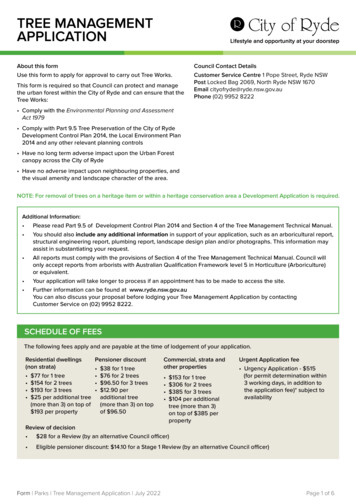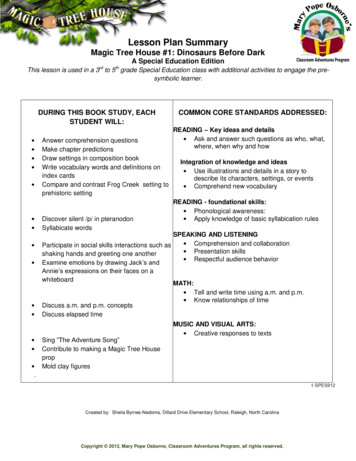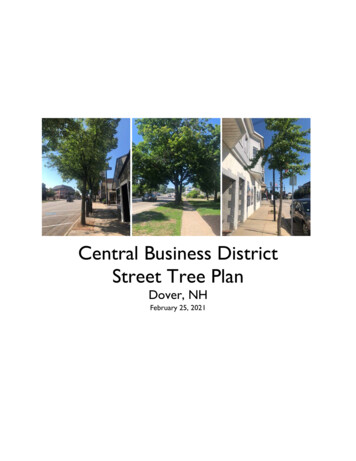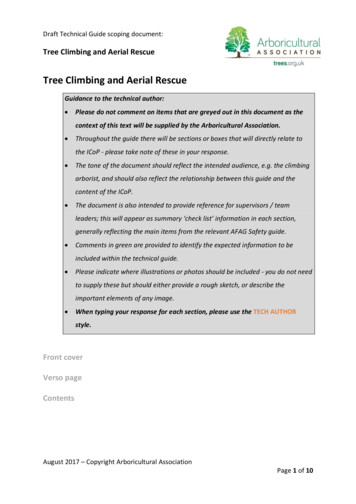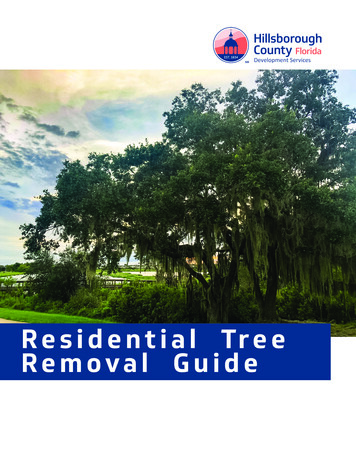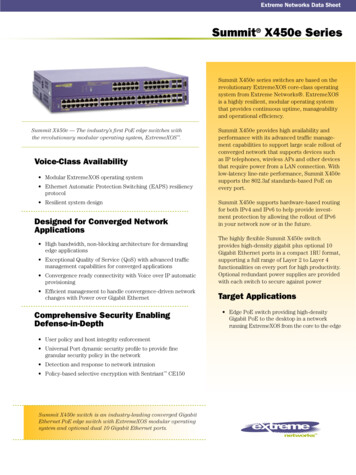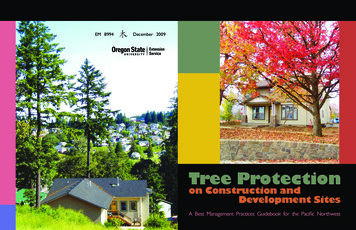
Transcription
EM 8994December 2009Tree Protectionon Construction andDevelopment SitesA Best Management Practices Guidebook for the Pacific Northwest
introduction. 1What’s at StakePurpose ofGuidebookWho Should UseThis Guidebookprotectforestremnantstands . .Excellent StandProtection ZonecontentsPoor StandProtection ZoneBMPs forProtecting NativeForest Remnants2protectindividualtrees .3Why Protect TreesTree ProtectionTechniqueschanginggrade aroundtrees . 8 maintaintreesRaising the Existing properly.Critical Root Zone GradeProtectionLowering theBMPs for TreeExisting GradeProtectionTrenching10Don’t Top Trees!Tree MaintenanceBMPs for TreePruningProper TreeRemoval andReplacementBMPs for TreeRemoval andReplacementplanting &establishingnew trees. .14Proper TreePlantingBMPs for TreeEstablishment
introductionINTRODUCTIONPurpose of GuidebookThis publication is a guide for protecting, conserving, selecting, maintaining, removing, and replacingWhat’s at Staketrees on development sites in the Pacific Northwest.Urban forests consist of the native forestThe guidebook is designed to assist people whoremnants and the planted forested landwork with trees during the development andscapes in our cities.construction phases of both new and existingThe urban forest is a valuable resourceprojects to keep healthy trees a part of the urbanthat provides economic, environmental,and social benefits. Quality of life in cities environment through the use of accepted tree carestandards and practices.is enhanced when we have a canopy ofThis publication provides best management practrees shading our homes and streets, mitigating stormwater effects, providing energy tices (BMPs) developed and recommended by professional arborists, urban and community foresters,savings, and improving property values.and landscape architects. BMPs are widely acceptedResearch by the USDA Forest Serviceindicates that, for every 1 spent on urban practices and standards used by industry professionals and based on the best available research. Thetrees, 2.70 in benefits is returned.guidebook provides basic and practical informationAs forests in the Pacific Northwestabout methods to give trees planted or retained onbecome more fragmented throughdevelopment sites the best chance to survive andurbanization and development, we losethrive during and after the construction process.a significant amount of the ecosystemservices that forests provide, such as storm- Please note that while the BMPs in this guidebookwater and flood control, and mitigation of are widely accepted practices and standards, theydon’t guarantee 100% successful tree survival.greenhouse gases.While these practices are presented here asThis guidebook is designed to help thevoluntary guidelines, some local jurisdictions haveuser retain healthy trees that contributetree protection regulations that must be followed.these services and benefits.Contact your local planning department forspecific regulations for your area.Who Should Use This GuidebookThis guidebook is intended to support thebuilding, development, and constructionindustries. If you are a construction contractor or employee, builder or land developer,heavy equipment operator, landscapemaintenance contractor or employee, treecare service contractor or employee, orutility employee, this guidebook is for you.You are an important part of successful treeprotection efforts!This publication will also be helpful toengineers, landscape architects, and plannersthat are involved in planning and designingconstruction projects. It can be used as aproject planning and implementation tool, aswell as a resource for community education.The guidelines in this publication couldmake a significant difference to your construction site for years to come. Trees thatare treated as assets rather than liabilitiesmay save thousands of dollars on a projectthrough reduced stormwater infrastructureneeds and increased property values.1
protect forest remnant standsPROTECT FOREST REMNANT STANDSStands, groves, or patches of native Pacific Northwest trees, such asOregon white oak, Western red cedar, red alder, bigleaf maple, andDouglas-fir, are often found in urban or urbanizing areas. Theseecosystems are remnants of the larger forests that previously coveredthe area. They may range from less than a quarter acre to severalacres in size. Conservation of existing groves of native trees oftenprovides greater economic and environmental benefit than preserving individual trees in the developing landscape.Excellent Stand Protection ZoneHigh tree densities with an undisturbed understory are characteristics of a high-quality forest remnant worth preserving. An excellentstand protection zone has the following characteristics: Trees structurally support one another. Soil remains undisturbed. Wildlife uses are relatively unimpaired. Shady microclimate encourages naturalwoodland plants. Natural forest succession continues andforest regeneration is ongoing. The stand is visually attractive. Ecological functions are relativelyunimpaired.Poor Stand Protection ZoneScattered trees with a highly disturbed ormissing understory may not be worth saving. Apoor stand protection zone has the followingcharacteristics: Trees blow over easily due to lack of support. Soil dries out and soil erosion occurs due todisturbed soils and lack of understory. Forest microclimate is disturbed.A stand that may not be Sunlight and temperature increase.worth saving. Reproducedwith permission by the City of Weeds and invasive species take over.Chattanooga. Forest succession is interrupted and littleregeneration occurs. The stand is visually unattractive. Ecological functions are severely interrupted.BMPs for Protecting Native Forest Remnants Fence the entire stand, grove, or patch to protect understoryvegetation and soil as well as trees. Healthy soils require little if anyfertilization, pesticides, or irrigation to support tree health. Avoid removing vigorous, healthy trees and vegetation from the stand. Do not retain isolated single, tall, spindly trees; such trees are morelikely to become structurally unstable, bend or blow over in storms,or become diseased and/or infested with insects. Avoid creating new forest edges that may not be wind-firm; retainlarge trees that are on the windward side of a stand to provide supA stand to protect. Reproduced withpermission by the City of Chattanooga.port and protection to the interior of the stand.2
protect individual treesPROTECT INDIVIDUAL TREESWhy Protect TreesTrees should be protected throughout their lives from damage tomaximize their health, safety, functionality, and benefits. Young,newly planted trees need protection as much as large, maturetrees.Protecting trees in new and existing developments reduces long-term tree maintenance and replacement costs; reduces site preparation and grading costs; provides immediate aesthetic and economic benefits becauseproperties with more mature trees and greater tree canopy coversell faster and accrue property value faster in comparison toproperties without these assets; generates positive response from neighbors and the surrounding community; generates good public relations; and provides healthier trees, forest ecosystem, and environment fora healthier, safer, more vital community.Tree Protection TechniquesTree protection involves activities designed to preserve and protecttree health by avoiding damage to tree roots, trunk, or crown. Sitedevelopment planning prior to site disturbance should includeidentifying tree protection zones (TPZs) for all trees designated forretention.Tree protection may be passive or active. Passive tree protection,most commonly used during the planning or post-development stages,simply means avoiding any disturbance or harmful activity near thetree. Active tree protection, by contrast, involves physical protectivebarriers and is generally required during any site disturbance thatmay impact retained trees, such as grading, building construction andmaintenance, infrastructure and utility installation and maintenance,and other landscape changes that may affect the structural integrityand stability of retained trees.Critical Root Zone ProtectionA critical step in retaining healthy trees during construction anddevelopment is the protection of tree roots from disturbance. Each treehas a critical root zone (CRZ) that varies by species and site conditions. The International Society of Arboriculture (ISA) defines CRZas an area equal to 1-foot radius from the base of the tree’s trunk foreach 1 inch of the tree’s diameter at 4.5 feet above grade (referred to asdiameter at breast height).Critical root zone radius distances calculated by tree diameter at breast height.Tree diameter2 inches6 inches20 inches46 inchesCritical rootzone radius2 feet6 feet20 feet46 feetTotal protection zone diameter,including trunk4 feet13.5 feet42 feet96 feet3
protect individual treesAnother common rule of thumbis to use a tree’s dripline to estimatethe CRZ (see figure). We recommendyou evaluate both of these and choosewhichever provides the larger CRZ.Under certain circumstances, disDriplineturbing or cutting roots in a CRZ maybe unavoidable. In such cases, thework should be done only under theCRZonsite supervision of an ISA certifiedarborist.Using dripline to estimateCutting or disturbing a largecritical root zone (CRZ).Adapted with permission bypercentage of a tree’s roots increasesthe City of Chattanooga.the likelihood of the tree’s failure ordeath. Most tree roots over 4 inchesin diameter are likely to be structural roots; cutting these rootsmay impact the structural stability of the tree, creating thepotential for catastrophic failure (the tree may fall over).The BMPs listed below retain good air and water supplyto the critical roots of protected trees, as well as protect themfrom mechanical damage, to help trees remain as healthy andstable as possible during the construction process and beyond: Establish a CRZ for both large and small trees. Install strong fencing around the CRZ and require the fenceto remain in place for the life of the development project toensure protection. Post appropriate signage to help convey the importance of theCRZ to workers. Avoid cutting tree roots over 4 inches in diameter. Make all necessary cuts to tree roots cleanly with sharp tools;never tear with a backhoe. A clean cut encourages good woundclosure and confines the spread of decay.To protect trees and tree roots within the fenced CRZ, do not dothe following: Stockpile construction materials or demolition debris. Park vehicle or equipment. Pile soil and/or mulch. Trench for utilities installation or repair, or for irrigation systeminstallation. Change soil grade by cutting or filling. Damage roots by grading, tearing, or grubbing. Compact soil with equipment, vehicles, material storage, and/orfoot traffic. Contaminate soil from washing out equipment (especially concrete) and vehicle maintenance. Install impervious parking lots, driveways, and walkways. Attach anything to trees using nails, screws, and/or spikes. Wound or break tree trunks or branches through contact withvehicles and heavy equipment. Wound trunks with string weed trimmers and lawn mowers. Cause injury by fire or excessive heat.4
protect individual treesSome tree species are more tolerant of damage anddisturbance in the CRZ than others. A tree’s tolerancedepends not only upon the species but also upon conditions present prior to and at the time of the damage. Treehealth, age of the tree, soil aeration and moisture, the timeof year the damage occurs, its severity, and the weatherconditions prior to, during, and after the damage allcontribute to the tree’s response. An experienced ISA certified arborist can analyze these variables and make specificrecommendations to retain or recover a tree’s health andsafety during and after the construction process.BMPs for Tree ProtectionPlanning Plan and budget for tree conservation and protection aspart of the development process. Plan for tree protection at least one growing seasonprior to the beginning of construction activities, wherepossible. Employ an ISA certified arborist or an urban foresterwhenever possible to assist in tree protection planning, implementation, monitoring, and follow-upmaintenance. Plan to protect trees located on adjacent property,including those portions of the roots, trunk, and crowngrowing into or over the developing property. Evaluate soil health and past site damage; incorporate that information into tree protection measures. Evaluate existing trees on the site. Locate buildings, other structures and infrastructure through evaluation of the opportunitiesand constraints of existing trees. Select trees to be conserved andprotected based upon their location, species, quality, health, andbenefits such as energy savings by shade or wind protection. Remove trees within 10 feet of the proposed building orstructure. Remove trees that cannot be adequately protected. Remove trees that have less than one-quarter of their total heightcomposed of tree crown (tall and spindly), or those with morethan one-third of the trunk wounded. Do not remove the best trees. Conserve and protect trees in stands or groups where possibleto facilitate their protection and maintenance, and to keep theforest structure intact. Establish substantial penalties for tree damage and noncompliance with tree protection requirements. Complete preconstruction tree maintenance, including mulch,fertilization, supplemental irrigation as necessary, and pruning toremove dead, structurally weak, and low-hanging branches. Engage maintenance staff in early decision-making and education about care of retained trees.5
protect individual treesFencing for tree protection. Reproduced with permission by the City of Arlington, Virginia.Implementation & Monitoring during Construction Educate all workers on site about tree protection techniques andrequirements during preconstruction meetings and by sharing thisguidebook with them. Establish a TPZ based on a tree’s CRZ (discussed above). Establish TPZs early, during site planning prior to construction. Erect barriers or sturdy fencing around individual trees or groupsof trees to define and protect CRZs (see figure). Protect high-value trees with stem, branch, and root padding orwraps in addition to CRZ barriers. Clearly identify the perimeter of TPZs with highly visible signs. Establish one access route into the site and one exit route out ofthe site. Confine construction offices, vehicular parking, worker breaksites, and material storage to locations outside TPZs. Avoid trenching through the CRZ of protected trees. Alter routesof underground infrastructure or use alternate methods such aspipe boring. Do not trench or excavate the soil within CRZs. Tunnel or bore atleast 18 inches beneath CRZs to install utility lines. Where tree roots must be cut, make only sharp, clean cuts topromote root callusing and regeneration. Remove badly damaged trees that may attract insects and disease. Evaluate the potential of dead, damaged, or dying trees for wildlifehabitat either as standing dead or woody debris if left onsite. Monitor tree health and compliance with tree protection requirements regularly during construction.6
protect individual treesFollow-up Maintenance Complete postconstruction tree maintenance, includingmulch, fertilization, irrigation, soil aeration, and pruningwhere necessary. In the absence of adequate rainfall, apply at least 1 inch ofwater per week by deep soaking methods. Fertilize trees with phosphorus, potassium, calcium, magnesium, and other macro- and micro-nutrients as indicated by asoil test, but wait at least 1 year to apply any nitrogen. Fertilize lightly with nitrogen after 1 year. If recommendedby an arborist, light annual applications of nitrogen may bemade for the next 3 to 5 years. Inspect trees annually for at least 3 to 5 years after construction to look for changes in condition and signs of insects ordisease, and to determine maintenance needs. Remove trees that are badly damaged or are in irreversibledecline if unsuitable for wildlife habitat. Continue to protect not only the large, established trees onthe site but also those newly planted in the landscape. Mulch trees on a regular schedule, ensuring that mulch doesnot rest against tree trunk. Develop a regular maintenance program that incorporates fertilization BMPs and integrated pest management techniquesto get best results at lowest cost.Ongoing Protection Strategies for Property Owners Maintain an “invisible” passive TPZ around all important “keeper”trees throughout their lives. Avoid damage to tree trunks and bark from mowers and stringweed trimmers by maintaining a mulched, grass-free area aroundthe tree. Avoid trenching in the CRZ for utility line and irrigation systeminstallation. Avoid damage to tree limbs and trunks during home maintenanceand repair projects. Avoid soil contamination from oil, gasoline, paint, paint thinner,or other chemicals. Do not attach wires, cables, conduit, mailboxes, or other objects totrees. Do not park or drive cars, trucks, or heavy equipment within theCRZ. Avoid placing paved walkways and driveways within the CRZ ofvaluable, large, and mature trees. Protect trees from domestic pets and livestock. Root damage dueto soil compaction, as well as trunk and bark damage, is commonon sites used by horses, cattle, and other livestock. Increase a tree’s CRZ and TPZ as the tree gets older and larger.7
CHANGING GRADE AROUND TREESchanging grade around treesChanging the grade around the base of a tree by adding or removingsoil may seriously disturb the delicate and vital relationship betweenroots and soil, affecting the tree’s health, soundness, and structuralstrength. Grade changes should be avoided in order to prevent serious damage or death to a tree.Raising the Existing GradeWhen fill is added over existing soils, air and water that are essential for normal root functioning may be blocked. As a result, rootssmother and die. This effect is compounded when the added soil iscompacted for construction purposes.Soil piled around the trunk may lead to conditions at the base ofthe trunk that invite rot, disease, and pests into the tree, compromising its health and safety. Even temporary fills such as stockpilingmulch or soil in the CRZ of a tree for as little as several days duringthe construction process can have severe, long-term negative effects.Visual symptoms include small yellow leaves, presence of numerous suckers along the main trunk and branches, many dead twigs andin some instances large dead branches (may appear within a monthor may not appear for several years).The extent of injury from adding soil around a tree varies withthe kind, age, and condition of the tree; the depth and type of fill;drainage; and several other factors. Maple, oak and evergreens aremost susceptible, while elm, ash, willow, sycamore, and locust areleast affected.Little can be done to save trees that have been suffering from soil addedover an extended period of time. It is prudent to consider possible damagethat may occur to a tree and take alternative action before the fill is made;prevention is less expensive and more effective than attempting to correctthe situation after damage has been done.BMPs for fill operations include the following: Never place any fill or organic materials directly against the tree. Never compact the soil within the CRZ. If no more than 2 to 4 inches of fill is used around existing trees, significant damage may be avoided if the fill has a coarser texture than theexisting soil.Lowering the Existing GradeLess damage to a tree’s roots is likely when the grade is lowered than whenit is raised, unless a great deal of the root mass is exposed or removed.Removing 1 to 2 inches of soil normally will not affect a tree adversely,especially if steps are taken to ensure that drought damage does not resultfrom loss of roots or root cover. A general rule-of-thumb used by landscapearchitects is to remove no more than 6 inches of soil from the existinggrade in the CRZ; however, this is dependent on the soils in which thetree is growing. A tree’s roots may all exist in the top foot of a shallow soil;removing the top 6 inches would have tremendous negative impact in thatcase.BMPs for removing soil include the following: Consider removal and replacement if the tree is young, in poor condition, an undesirable species, or very susceptible to insects and disease.8
changing grade around trees Plan grade changes well in advance of construction using the appropriate method toprevent injury to desirable trees. Use retaining walls or terraces to avoidexcessive soil loss in the area of greatest rootgrowth. Spread mulch over the exposed root areawhen possible to help prevent soil erosion,reduce moisture loss, and keep soil temperatures lower. Provide supplementary water when rainfall isless than 1 inch per week. Prune roots to prepare the tree for root lossdue to grade lowering. Root pruning is bestleft to an experienced professional who cantake into account the variables necessary toreduce the stress of the pruning to the tree.ingly; such realignments are not the responsibilityof the construction crew.BMPs for trenching include the following: Protect the trunks of high-value trees fromscraping and gouging to a height of at least 8feet. Keep equipment and excavated backfill onthe side furthest from the tree, not against thetrunk. Place excavated backfill on a plastic or canvastarp outside the CRZ. Prune away jagged roots back to the trench wallclosest to the tree. Use a handheld pruner orpruning saw to make sharp, clean cuts. Replace the backfill on the same day if at allpossible. Cover exposed roots with wet burlapto prevent them from drying out; in hot dryProposed trench through a critical root zone. Adapted withpermission by the City of Chattanooga.conditions, small roots may be injured in asTrenchinglittle as 30 minutes.Trenching is a standard way to install utilities.tree’s roots are within the top 18 inches of soil. Do not allow chemicals, trash, or other foreignIt is best to entirely avoid trenching throughTunneling beneath the root zone will preventdebris to become mixed with the backfill.the CRZ (see figure); such practice couldloss of critical root mass if underground utilities If earthwork specifications allow it, firm theseverely destabilize a tree, as well as adverselymust unavoidably be placed within the CRZ.backfill to the same compaction as the suraffect its health through loss of roots. WorkersA decision must be made as to where best torounding soil and no more.performing such operations should understand locate utility trenches. Planners and designers Water the backfill to prevent excessive rootthat 85% of the mass of a tree’s root systemmust be made aware that trenches may not crossdrying.is located within the CRZ and that most of aa CRZ and design alternate alignments accord-9
maintain trees properlyMAINTAIN TREES PROPERLYDon’t Top Trees!Some people “top” trees because they interfere with views or sunlight,or simply grow so large that the homeowner becomes concernedabout personal and property safety. Topping to control a tree’ssize, however, is usually self-defeating. Ugly, bushy, weakly attachedbranches typically grow back even taller than the original limbs andmay break or fall with little or no cause.Here are some important facts about tree topping: Topping violates all accepted pruning practices. Proper tree selection and pruning practices may prevent or remove excessive growthwithout the problems that topping creates. Topping will not make trees safe; in fact, it makes them morehazardous. Topping starves the tree by drastically reducing its ability to feeditself through photosynthesis. The open wounds of topping make a tree more susceptible tointernal rot, insects, and disease. Topping makes a tree more susceptible to storm damage. Topping is an assault on the health and beauty of your tree. Topping is a waste of your money. Topping increases future maintenance costs and the likelihood of removal as a hazardous tree inthe near future. Topping may inhibit the value and sale of your property.Tree MaintenanceThe amount of maintenance a tree requires depends on the species,the tree’s location in the landscape, its age, and the care (or abuse)it has been given throughout its lifetime. Basic tree maintenancebegins with regular inspections to determine a tree’s needs, whichmay include pruning, mulching, fertilization, irrigation, and pestmanagement. This guidebook focuses on pruning.Pruning is the deliberate removal of tree branches and limbs toachieve a specific objective in the alteration of a tree’s health andform. Regular inspections to determine a tree’s pruning needsshould be a part of every tree maintenance program. Always determine the objective for pruning before beginning the work.The benefits of regular, correct tree pruning include the following: better tree form, health, and structural integrity removal of decaying and diseased wood that threaten the healthand structural stability of a tree increased structural strength, stability and resistance to winddamage decrease in overall risk of limb failure due to dead or diseasedlimbsSome common mistakes made in tree pruning include thefollowing: the use of detrimental techniques such as topping, stub cuts, flushcuts, and bark tears at pruning cuts using spikes to climb trees for pruning10
maintain trees properly Never top a tree. deferring pruning until limbs get large (largelimbs equal large wounds, which are more dif- Never use climbing spikes or spurs whilepruning trees.ficult for a tree to compartmentalize and leave Trees should be inspected before climbthe tree open to disease, insects, and rot)ing to determine the amount and extent pruning trees on a crisis-only basisof hazards, and the tree’s owner should attempting to reduce tree size as a substitutebe notified of potentially hazardous orfor proper tree selection and placementharmful conditions.The American National Standards Institute Keep pruning equipment sharp, clean,and in good operating condition.(ANSI) publishes tree pruning and safetystandards, known as ANSI A300 (Part 1): Tree, When pruning trees that show evidenceof disease, disinfect pruning equipmentShrub, and Other Woody Plant Maintenancebetween trees. During extreme infesta– Standard Practices (Pruning). The ISA hastions, disinfect equipment between cuts.developed BMPs for pruning in relation Always prune trees back to the parentship to the ANSI standards; these guidancebranch or a lateral branch (see figure) thatdocuments are available for sale through theis at least one-third the diameter of theISA Web site (http://secure.isa-arbor.com/branch being pruned.webstore/). Prune just outside the branch collar (seeBMPs for Tree Pruningfigure). Hire experienced, qualified professionals to Prune young or newly planted trees toprune trees. Arborists certified by the ISAremove dead, broken, crossed, or rubbingare required to pass a written test of basicbranches.arboricultural knowledge and to maintain Train young trees to develop strongtheir certification through continuingbranch structure, strength, and formeducation.through proper pruning.Cut 2Cut 1Cut 311The three-cut pruning method. Cut 1 is a shallow undercutto break the continuity of the bark to prevent tears fromoccurring should you lose control of the branch. Cut 2 is madejust beyond cut 1 to remove the bulk of the branch. Cut 3 ismade just outside the branch collar, the swelling at the base ofthe branch, to finish the pruning cut properly. Adapted withpermission by Alex Shigo, Modern Arboriculture.
maintain trees properly Maintain a single leader by removing all but one leader on treeswith forked stems. Prune trees regularly throughout their life to maintain vehicular, pedestrian, and sight clearance; and to remove dead,diseased, and broken branches. Make proper pruning cuts using the three-cut method (seefigure). Avoid stub cuts, flush cuts, and wounds to other limbs and thetrunk. Do not remove more than one-quarter of the foliage of a maturetree in any one growing season. Do not remove more than one-third of the foliage of a youngtree in any one growing season. Do not remove more than one-quarter of the foliage from abranch unless you are removing the entire branch. Always wear personal protective safety equipment while pruning, including safety glasses. Never prune or remove trees located near electrical or other utility lines; contact the local utility service provider to have a treegrowing beneath utility lines pruned or removed. Talk to your local utility provider about the need for line clearance and the pruning techniques designed to maintain thatclearance.Proper Tree Removal and ReplacementTrees may need to be removed for a number of reasons. They maybe a poor selection for the location, lack adequate growing space,or conflict with hardscape such as driveways and sidewalks or otherinfrastructure such as buildings, roadways, or utility services. Trees, likeother living creatures, have a finite lifespan. Trees that are dead or inpoor or hazardous condition may require removal to protect the safetyand wellbeing of the owner or the public in general. Some species oftrees may be invasive, crowding out native plants and thus reducinghigher quality habitat for native wildlife. Whatever the reason forremoval, the site should be evaluated to determine whether anothertree can be planted in the same location or nearby to maintain treecanopy cover in the area.Everyone needs to understand that some tree removal must occurand that it is not necessarily a bad thing. The goal
Tree protection involves activities designed to preserve and protect tree health by avoiding damage to tree roots, trunk, or crown. Site development planning prior to site disturbance should include identifying tree protection zones (TPZs) for all trees designated for retention. Tree protection may be passive or active. Passive tree protection,
